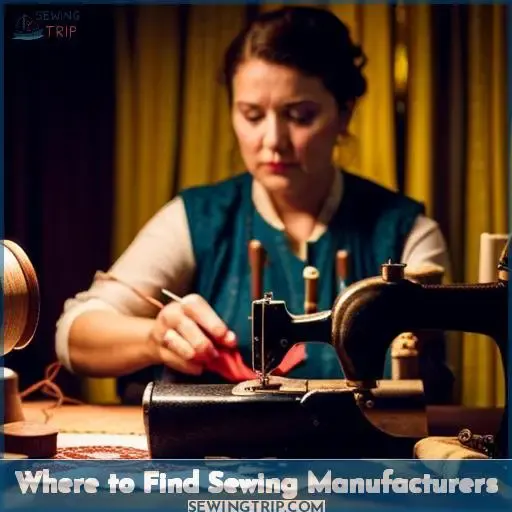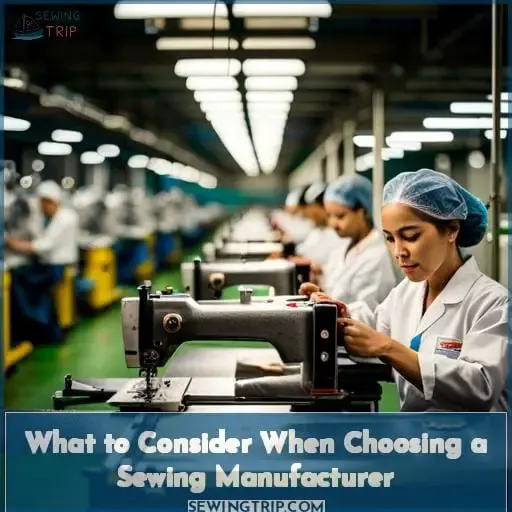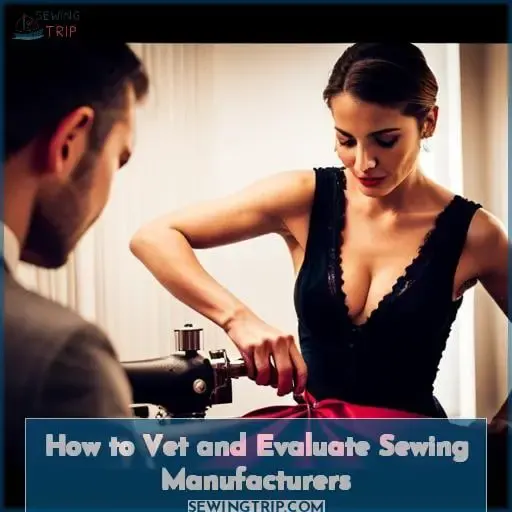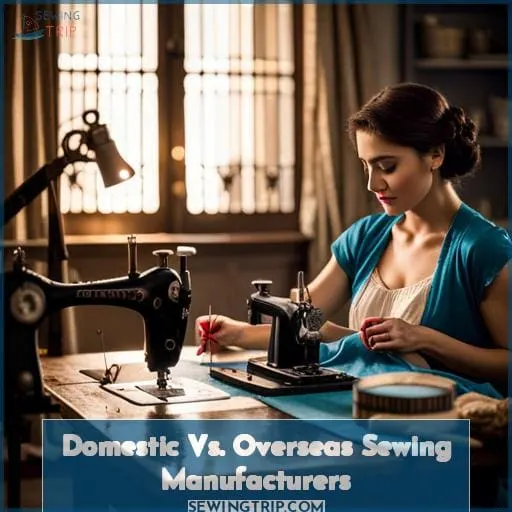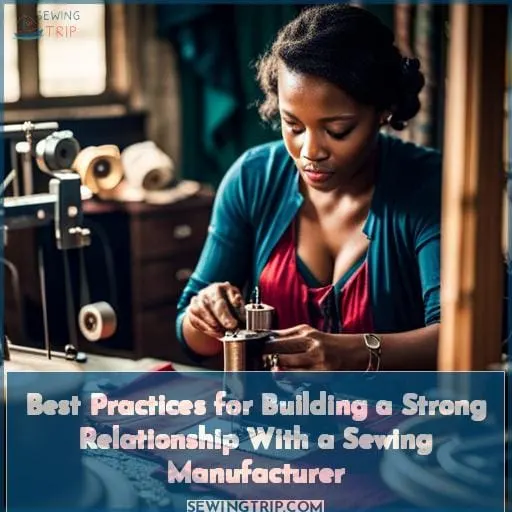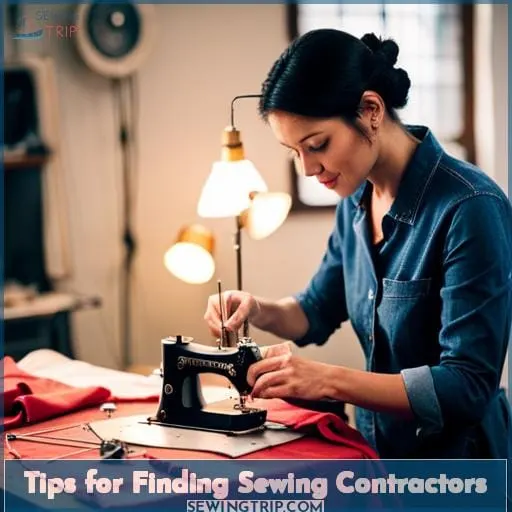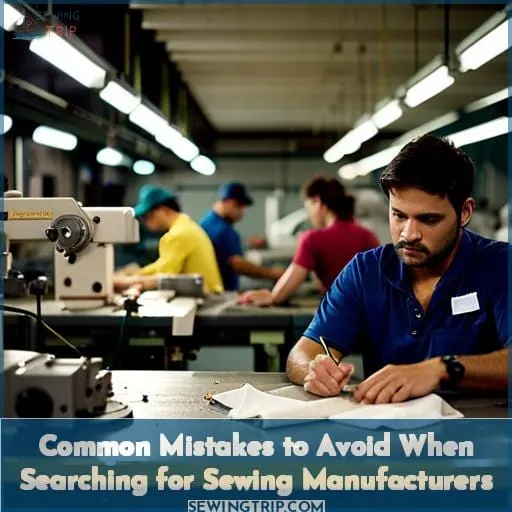This site is supported by our readers. We may earn a commission, at no cost to you, if you purchase through links.
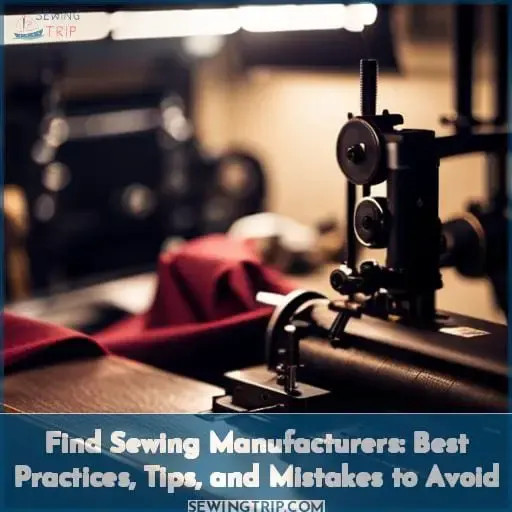 Developing a profitable apparel business calls for working with a skilled sewing manufacturer. The process of finding one can feel overwhelming at first, but with research and care, you’ll soon partner with a top-notch producer.
Developing a profitable apparel business calls for working with a skilled sewing manufacturer. The process of finding one can feel overwhelming at first, but with research and care, you’ll soon partner with a top-notch producer.
Start your search online through manufacturer directories or at trade shows and exhibitions. Consider the services offered, production capacity and lead times, quality standards, pricing and minimum orders, and communication responsiveness when evaluating options.
Weigh the pros and cons of domestic versus overseas manufacturing. Factors like cost effectiveness and turnaround times impact this decision.
Ensure shared expectations by clearly communicating needs throughout relationship building. This paves the way for long-term partnerships. With preparation and due diligence, you’ll find the perfect manufacturing match.
Table Of Contents
- Key Takeaways
- Where to Find Sewing Manufacturers
- What to Consider When Choosing a Sewing Manufacturer
- How to Vet and Evaluate Sewing Manufacturers
- Domestic Vs. Overseas Sewing Manufacturers
- Best Practices for Building a Strong Relationship With a Sewing Manufacturer
- Tips for Finding Sewing Contractors
- Common Mistakes to Avoid When Searching for Sewing Manufacturers
- Conclusion
Key Takeaways
- Use online directories, trade shows, and industry associations to find a skilled sewing manufacturer.
- Assess criteria such as services offered, production capacity, quality standards, and pricing.
- Think about domestic versus overseas manufacturing based on cost, turnaround times, and quality.
- Concentrate on building strong partnerships through clear communication, responsiveness, and shared goals.
Where to Find Sewing Manufacturers
Finding the right apparel manufacturers and sewing contractors can feel overwhelming. Excellent resources to discover suppliers that are the perfect fit for your clothing line include online directories like Maker’s Row and Common Objective, trade shows like Sourcing at Magic, and industry associations like the CFDA.
With persistence and networking, do not get discouraged – you will find an ideal partner.
Online Directories
You can overcome doubts about which online directory to trust by researching audience reviews and industry recommendations for comprehensive supplier listings such as Kompass, Maker’s Row, and Sqetch. Prominent trade shows and industry associations also enable directly evaluating production capacity and quality standards when selecting apparel manufacturing partners.
Separately, evaluate potential sewing contractors and custom clothing manufacturing companies possessing expertise that matches your startup’s goals.
Trade Shows and Exhibitions
Attending trade shows and exhibitions allows for networking with sewing contractors in person while evaluating their capabilities.
Trade shows provide opportunities to meet suppliers from around the world in one location. Seeing machinery and products firsthand is invaluable when assessing a manufacturer’s capabilities. Connecting face-to-face builds stronger relationships than online interactions alone.
Comparing multiple suppliers side-by-side helps determine the best fit for your production needs. Trade shows offer a chance to discover new technologies and innovations impacting the industry.
Interacting directly with potential partners at trade events is an efficient way to vet vendors thoroughly before making a final manufacturing decision for your clothing brand.
Industry Associations and Networks
Discovering kindred spirits within trade unions and peer-to-peer groups could garner game-changing contacts.
| Industry Associations | Networking Events | Online Communities |
|---|---|---|
| Join local chapters | Attend industry meetups | Search Facebook groups |
| Follow on social media | Exchange business cards | Join relevant subreddits |
| Read trade publications | Give a short elevator pitch | Post questions in online forums |
Connecting with others who share your passion for apparel manufacturing can lead to valuable relationships and insider knowledge.
What to Consider When Choosing a Sewing Manufacturer
Choosing the right sewing manufacturer is critical for your business. Evaluate suppliers based on the types of sewing services offered, production capacity and lead times, quality standards, and pricing models including minimum order quantities.
When comparing manufacturers, look at the specific sewing capabilities like embroidery, cut and sew, and printing to ensure they can provide the services you need. Ask about typical production lead times and rush order options to make sure they can meet your deadlines.
Review quality control procedures, inspect sample products, and ask for references to verify they consistently deliver well-made products. Compare pricing models including per unit costs, minimums, and discounts for higher quantities to find the most budget-friendly option.
Selecting the right partner can help you get quality sewn goods produced efficiently and cost effectively.
Type of Sewing Services Offered
- Specialization – Look for expertise in your specific product types like dresses, activewear, suits, etc.
- Production Process – Do they handle design, pattern making, cutting, sewing, finishing in-house or outsource steps?
- Quality Control – What testing and inspections ensure consistency and durability.
- Pricing – Compare rate structures across suppliers specializing in your products.
Production Capacity and Lead Time
In addition to immense order quantities, ensure your clothing manufacturer can meet short lead times, as startups frequently sell out quickly and need products fast or risk losing impatient customers. When vetting suppliers, ask probing questions about production capacity, lead times, and quality control to confirm they can handle your startup’s growth.
Avoid factories prioritizing profits over small brands, or you may encounter deprioritized production.
Quality and Standards
Don’t cut corners when it comes to quality.
Before ordering bulk production, closely inspect initial samples and provide detailed feedback. Verify adherence to your quality standards through material inspection, sewing techniques, and compliance checks.
Request certifications proving manufacturers follow safety regulations and ethical labor practices. Choosing an experienced partner with stringent quality control translates to stellar, long-lasting products you can take pride in.
Pricing and Minimum Order Quantity
Consider manufacturers’ pricing structures and minimum order quantities, ensuring they align with your production goals before selecting a partner. Prototyping and sampling often have higher costs than bulk orders. Carefully analyze pricing tiers based on order sizes and production runs.
Budget accordingly, negotiate minimums if able. Target suppliers with minimums and pricing that fit your budget today and anticipated growth trajectory tomorrow.
How to Vet and Evaluate Sewing Manufacturers
Thoroughly assessing potential sewing partners is crucial. Request product samples and review their portfolio to begin evaluating them. Visiting their manufacturing facility in person allows you to evaluate it firsthand.
Assess their communication skills and responsiveness as well. This provides a comprehensive vetting of potential partners.
Requesting Samples and Portfolio
Once you’ve narrowed your list, demand to see the manufacturer’s entire catalog to get a sense of their range and quality.
- Request physical samples of the manufacturer’s work to evaluate quality firsthand.
- Schedule an on-site visit to assess their production capabilities and team.
- Open clear communication channels and gauge responsiveness before committing.
Evaluating samples and portfolios establishes trust in potential partners to create quality products that meet your brand’s high standards and vision. Select manufacturers invested in building long-term collaborative relationships through transparency.
Visiting the Manufacturing Facility
After sending your tech packs, check availability to tour their factory and offices. Walking through a potential supplier’s manufacturing facility provides invaluable insights. Observe their production process, manufacturing standards, quality control, and construction techniques firsthand.
Engage factory representatives to assess capabilities, capacity, lead times, and whether the clothing styles you envision align with their specialties. The hands-on experience from an in-person facility tour enables you to evaluate if a sewing manufacturer is the right fit.
Assessing Communication and Responsiveness
You’ll want your manufacturer to respond promptly to avoid delays. Look for a supplier that provides timely feedback and is easy to reach. Assess turnaround times on inquiries and samples. Responsiveness in answering questions and providing solutions creates an efficient, hassle-free partnership.
A manufacturer available to discuss issues shows care for clients. Prioritize seamless communication that keeps your clothing line progressing smoothly.
Domestic Vs. Overseas Sewing Manufacturers
When choosing between domestic and overseas sewing manufacturers, you must weigh the pros and cons of each option carefully. Consider factors like cost, production time, ability to oversee quality control, and aligning values between brands when deciding where to produce your clothing line.
Pros and Cons of Domestic Manufacturing
The appeal of domestic manufacturers for perceived quality and efficiency is understandable, but weigh their higher costs against your budget and growth plans. Pros of domestic production include quality assurance, regulated labor, and fast shipping.
Cons are higher prices and minimum order quantities. Analyze whether the quality justifies premium pricing. Ensure flexibility, certification standards, and production requirements fit your product quality goals within your budget.
Pros and Cons of Overseas Manufacturing
With overseas suppliers, you have to be watchful of shipping times and potential quality issues, because those factors can really mess with your business. Deciding between domestic and foreign suppliers means weighing the pros and cons.
Overseas can cost way less but product quality and shipping delays are huge risks. Doing your due diligence to vet manufacturers is key, as is having a failproof quality assurance process. The key is balancing cost savings against potential headaches down the line. Choose wrong and you’ll be swimming upstream.
Factors to Consider When Making a Decision
- Delivery timelines – Domestic production allows for quicker turnaround while overseas production can take weeks for shipping.
- Flexibility – Domestic manufacturers may accommodate smaller batches and design changes more easily.
- Cost savings – Although overseas production is less expensive, import duties can add hidden costs.
Evaluating shipping costs and manufacturing schedules helps determine whether domestic or overseas production works best for your startup. Weighing these key factors allows you to find the ideal cut and sew partner to create your custom designs.
Best Practices for Building a Strong Relationship With a Sewing Manufacturer
Focus on building a strong relationship with your apparel factory through excellent communication, feedback, collaboration, and problem solving. Establish clear expectations up front and nurture an open, long-term partnership to get the most out of working with a sewing contractor.
Clear Communication and Expectations
When scouting a clothing partner, mind how the phrases you wield assist in cementing terms. Resultive communication initiates with delineating lucid guideposts and hopes early on. This impedes misconceptions downstream. Foster trust by being see-through. The clothing production demands adroit project steering.
| Do | Don’t |
|---|---|
| Be blunt | Abstain from open-endedness |
| Inquire for illumination | Take for granted |
| Record pacts | Depend on handshake or verbal pacts |
| React fast | Vanish for elongated stretches |
| Issue feedback politely | Point digits or tax blame |
Concrete communication and prospect setting enable apparel fabrication to purr sans hiccups.
Regular and Transparent Feedback
Once manufacturing begins, provide transparent feedback through inspections and honest communication with your manufacturer. This could happen through visits to the factory to inspect samples or finished goods.
Conduct periodic evaluations of product quality. Provide suggestions for improvement while also praising what they do well. Work as partners, not adversaries. Frequent, considerate feedback strengthens your relationship and leads to better quality over time.
Collaboration and Problem-Solving
Stick together for troubleshooting and problem resolution during the early stages. Last year alone, nearly 80% of startups faced significant manufacturing issues, spiking production costs. When production problems arise, maintain open communication channels with your manufacturer.
Approach issues as a team, not in an adversarial manner. Brainstorm innovative solutions together. Find compromise when opinions differ. A strong, collaborative partnership enables you to navigate challenges.
With persistence and creativity, you can resolve problems in ways that strengthen your relationship and project.
Long-Term Partnership Opportunities
Let’s focus on long-term partnerships with your sewing manufacturer. Establishing a partnership based on good communication, shared goals, and mutual understanding fosters loyalty and commitment over time.
View your manufacturer as a trusted partner, not just a vendor. Nurture this bond through openness, patience, and a shared vision to grow your business. With the right partner, you can build an extended, fruitful collaboration that enables both parties to excel.
Tips for Finding Sewing Contractors
Are you having trouble connecting with sewing manufacturers for your apparel startup? You can find contractors on online directories like Maker’s Row and Sketch, leverage connections at local fabric stores, seek referrals through networking, or tap into online communities focused on sewing and manufacturing.
Online Directories and Platforms
Connect with sewing contractors on industry directories and marketplaces to broaden your search. Join online databases like Maker’s Row and Sqetch to connect with domestic and overseas apparel manufacturers.
Attend trade shows like Sourcing at MAGIC to meet suppliers in person. Leverage industry associations to network and get referrals. Focus domestically if you prioritize quality and fast shipping or overseas to reduce costs with bulk orders.
Local Sewing and Fabric Stores
Check the local sewing shops; their fabric sources may be able to stitch custom orders. Seek out independent contractors around your hometown who specialize in crafting beautiful, customized garments. Visit local fabric stores and chat with the owners about connecting with their best sewing contractors.
You’ll find artisans passionate about high-quality, detail-oriented work. Collaborating with local sewing professionals enables small brands to appreciate master tailors while supporting sustainable community business practices.
Networking and Referrals
Hop on LinkedIn and ask fellow clothing brands for manufacturing referrals. Referral networks provide trusted recommendations from brands with experience. Attend industry meetups, join Facebook groups like Shopify Entrepreneurs, and network online.
Google lacks the human touch of referrals for finding the right sewing factory match.
Online Communities and Forums
Joining industry forums and communities can provide insider insights when vetting sewing contractors. Online networking allows you to virtually connect with industry experts worldwide. Community engagement gives access to trusted reviews, supplier referrals, and behind-the-scenes production advice.
Web-based groups share invaluable guidance on everything from product cost to marketing materials, helping you make informed decisions on price and quality during your search for the ideal sewing manufacturer.
Common Mistakes to Avoid When Searching for Sewing Manufacturers
Finding the perfect sewing manufacturer for your clothing line can be tricky, so avoid some common rookie mistakes. Focusing too much on price comparison without considering quality and production standards, responsiveness and clear communication, or long-term partnership potential will lead you down the wrong path.
Relying Solely on Price Comparison
While price is important, solely relying on it could cost you in the long run. Ninety-six percent of entrepreneurs say trust and communication are the top priorities for a healthy supplier relationship.
The lowest overseas bid seems tempting at first, but quality issues down the road can sink your business. Vet samples thoroughly, ask for referrals, and visit facilities in person when possible. Prioritize clear communication and shared values over the bottom line; this builds partnerships that last, saving money and headaches long-term.
Neglecting Quality and Standards
Don’t only sweat quantity and cost; your clothes deserve care.
Finding quality sewing manufacturers requires going beyond price. Inspect production facilities, review quality control procedures, and examine materials.
- Request material certifications.
- Review quality assurance reports.
- Verify compliance with industry standards.
- Use inspection checklists.
Quality control prevents defects from reaching customers. Don’t cut corners building your brand.
Overlooking Communication and Responsiveness
Move swiftly now, yet carefully evaluate your options, looking for the responsive communicator who will champion your vision through action as neglect overlooks communication. Listen closely and observe keenly for signs of responsive communication. Ask probing questions to determine true responsiveness.
Pursue manufacturers who actively collaborate, with quality assurance embedded in communication and production processes. A shared commitment to growth through open communication attracts the long-term partner who can liberate your brand.
Not Considering Long-Term Partnership Potential
Look beyond temporary gains by ensuring a clothing maker can grow with you over the years. Rather than chasing the cheapest supplier, seek strategic partnerships. Assess potential collaborators’ reliability and longevity through reference checks.
Favor manufacturers invested in expanding production responsibly. Sustainable growth requires aligning with suppliers sharing your dedication to ethical practices. By building trusted relationships, you gain a creative ally able to support your vision long-term.
Conclusion
Finding the perfect sewing manufacturer can be daunting. But keep in mind there are many factors to consider before selecting a partner. Although it may seem challenging, take comfort knowing there are plenty of resources to help find the right fit.
From online directories to trade shows and industry networks, you can do your due diligence. Research your options. Prioritize quality, communication and fast response times. This will set you up for a successful relationship with a manufacturer. You’ll be ready to unleash your creativity and take your design vision to the next level.

